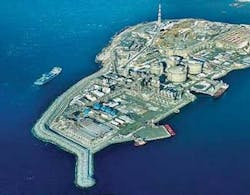Frank Hartley, Drilling/Production Editor
StatoilHydro’s Snøhvit field subsea field development project makes the Top 5 list as the world’s longest umbilical measuring 143 km (89 miles) permitting remote operations at a cost of NOK 58 billion ($10.4 billion). Lying in the Barents Sea in 250 m (820 ft) to 354 m (1,161 ft) of water, Snøhvit is three fields producing through the longest umbilical to the Melkoya plant near Hammerfest in northern Norway. StatoilHydro operates the field on behalf of Petoro, Total E&P Norge, Gaz de France, Hess Norge, and RWE Dea.
The fields were discovered 24 years ago and extends across seven production licenses that contain primarily natural gas with small quantities of condensate. The accumulation exceeds 193 bcm of gas and 113 MMbbl of condensate.
Snøhvit, which means Snow White, is the first major development on the Norwegian continental shelf without a fixed or floating unit. The subsea production system on the seabed feeds the Melkoya plant, at the entrance to the shipping channel into Hammerfest through a 68 cm (27 in.) ID gas pipeline. In addition, the system has two chemical lines, an umbilical, and a separate pipeline for transporting carbon dioxide.
Both the subsea production system in the field and pipeline transport is monitored and controlled from a room at Melkoya, where operators can open and close valves on the seabed 143 km (89 mi) away with signals transmitted along fiber-optic cables, and with high-voltage electrical and hydraulic power lines.
The unprocessed wellstream arriving at Melkoya is separated and the gas cooled to liquid form and exported. Gas from the Snøhvit contains 5% to 8% carbon dioxide, which is separated at the land plant and returned in a separate line for storage underground beneath the seabed.
A liquefaction plant reduces the gas volume 600 fold by decreasing its temperature to 163 ºC (-325 ºF). This is carried out on a gas liquefaction barge built at the Spanish shipyard group Izar Constructions Naval’s yard in Ferrol in a contract worth about NOK 170 million ($30.6 million). The barge measures 9 m (29.5 ft) high by 154 m (505 ft) long, by 54 m (177 ft) wide.
The projected annual exports are estimated to be 5.75 bcm (203 bcf) of LNG, 747,000 tons (4.9 MMbbl) of condensate and 247,000 tons (1.6 MMbbl) of liquefied petroleum gases (LPG).
Statoil began LNG production at Hammerfest on Sept. 13, 2007, after five years of development.
“Snøhvit is a fantastic industrial adventure we’ve been working on for many years,” says Tim Dodson, acting executive vice president for Statoil Exploration & Production Norway (EPN). “The start-up of LNG production 24 years after the discovery of the Barents Sea’s Snøhvit field is one of the absolute highlights in the project.”
The first tanker with a cargo of liquefied natural gas (LNG) from the Snøhvit field left port at Melkoya near Hammerfest, northern Norway on October 20.
“This is a historic milestone for the Snøhvit project and StatoilHydro’s LNG focus,” says Helge Lund, StatoilHydro’s chief executive. “For the first time, we are supplying gas from the Norwegian continental shelf in a cooled state by ship. This gives us increased flexibility in marketing gas globally. Our plant at Melkoya is the first LNG production facility in Europe and will be a key component in StatoilHydro’s focus on LNG, which constitutes the fastest growing gas market in the world.”






